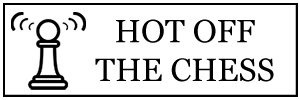
Round 3 of the Altibox Norway Chess Tournament 2016 was held on Thursday 21st April. Going in to the round, there was a three-way tie for the lead. By the end of it, this would be reduced to one.
Swedish Grandmaster, Nils Grandelius, has only scored a half point so far, and in this round things would not improve for him. He faced the World Champion, Magnus Carlsen, with the Black pieces. Grandelius clearly decided to take Carlsen on over the board rather than get in to a theoretical tussle, and played a 2…Nf6 sideline of the Sicilian. This can often be counter productive — openings are popular and less popular for good reasons usually.
Carlsen developed rapidly, and then took an interesting decision at his tenth move, to sacrifice the exchange in return for activity. The diagram above shows the position after Black’s 9…g4. Here, Carlsen continued 10.exf6, leading people to think he may have gone mad. However, as tuned in as always, the Norwegian talent was thinking long term. After 10…gxf3 11.Qf4 fxg2 12.Rg1 Black will probably have thought he had the better of things, and most chess engines will agree with that opinion.
However, chess foresight whilst over-the-board is something that no computer can emulate or get near. They will see a material imbalance and if there is nothing concrete for it, they will give the advantage to the player who has made the gain — even if his King position could be better, and his pieces are yet to be developed. All while his opponent becomes more and more active.
That was the situation, here, Carlsen made the investment, not for a winning attack, but for a position he felt he could use. In human, over-the-board chess, that is what we are looking to achieve. So, computer evaluations as to whether this was good or bad, can be ignored, it is now up to one player or the other to prove their case.
And soon the pendulum was swinging in White’s favour. This was largely due to Black’s difficulty in making constructive and active moves. And, in the space of a few moves, Black was giving up his rook for the very dangerous White f-pawn. With every move, Carlsen kept up the pressure, and Grandelius began to find himself out thought and out manouvered. White began to swarm the position, dominating the board, and picking up material.
When the endgame arrived, White was strategically winning. A big part of this was Black’s c8-bishop, which had still not moved. All that was left to do was convert the advantage. It was not to move in the entire game as it worked out — from the diagram position, below (following 35…d6), there came 36.Kf3 b5 37.g4 Kd7 38.Rh6 and Black resigned. A very nice, confident game by Magnus Carlsen, earning him sole lead of the tournament.
Carlsen, then, had set the standard for the round, and the other games had something to follow. Closest was Kramnik-Giri. Of course, the Dutchman had suffered a pretty heavy loss as White in the previous round, at the hands of Maxime Vachier-Lagrave. In this round he would have black himself and face former World Champion, Vladimir Kramnik.
The game was an extremely close affair, of 59-moves, in which niether player gave an inch. Unfortunately, in many ways it was a bit too balanced and this did not present many chances. In the endgame, Giri took the decision to give up his rook for White’s knight and this left him with a bishop and extra pawn versus White’s rook. There was little that could be done, however, and the material was given back to leave lone Kings and the point split.
Maxime Vachier-Lagrave and Pavel Eljanov got in to a Berlin Defence, and hopes were not high of much tension. They didn’t do too badly, producing a game of 52-moves, but the position did not yield much. Even when, in the endgame, White had a bishop and Black had 3 pawns, there was nothing possible due to them being doubled and un-connected and the point was split.
Aronian-Li Chao was a Grunfeld, in which the equalibrium was maintained all the way through. The players seadily exchanged down without much event. Harikrishna-Topalov was a 23-mover.
Standings after 3 rounds:
Carlsen — 2½
Vachier-Lagrave, Kramnik — 2
Li Chao, Topalov, Giri, Aronian — 1½
Harikrishna, Eljanov — 1
Grandelius — ½
Round 4: Friday 22nd April
Grandelius-Harikrishna
Giri-Aronian
Eljanov-Topalov
Li Chao-Carlsen
Vachier-Lagrave–Kramnik
Play begins at 16:00 local time. If you need to, you can check your time, here.
More Information: Atibox Norway Chess 2016 Website
